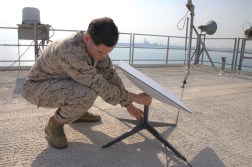Proliferated LEO, hybrid cloud capabilities enable U.S. forces to operate more disconnected

Emerging capabilities such as proliferated low-Earth orbit satellite communications and hybrid cloud capabilities will allow U.S. military forces to operate effectively without having to be constantly connected on the battlefield in the future, according to a Marine commander.
Unlike the conflicts in the Middle East of the last 20 years against a technologically inferior enemy, Pentagon officials anticipate contested and congested digital environments where maintaining connectivity will be difficult — a concept known as DDIL, or denied, disrupted, intermittent and limited, in Defense Department parlance.
“Because the bandwidth that’s available in these pLEO satellite connections to our ground control stations is so big, we’re talking hundreds of megabytes of bandwidth with negligible latency, it makes things possible that you couldn’t do anymore. You don’t need to be persistently connected anymore,” Col. Jason Quinter, commander of Marine Air Control Group 38, said during a webcast Monday hosted by C4ISRNET, adding that this also includes the cloud.
In the past, U.S. troops were used to constant connectivity to higher headquarters or to pass data back and forth. Now, they will have to operate somewhat disconnected at times, but these new technologies are providing more bandwidth in those scenarios.
“pLEO is a game changer … That high amount of bandwidth and that low latency really changes what’s possible on modern networks,” Quinter told DefenseScoop in an Oct. 7 interview. “Because the satellites are in low-Earth orbit, you have significantly less latency than you typically would. What that means is it makes certain things possible that wouldn’t [otherwise] be possible.”
These constellations provide orders of magnitude more bandwidth than traditional program-of-record SATCOM capabilities, where forces would have to aggregate connections together to achieve 12 megabytes. Now, troops can have up to 200 megabytes or more depending on how much officials are willing to spend, allowing unprecedented connectivity and data.
Those constellations are also more resilient given there are more smaller satellites in orbit as opposed to a lower number of exquisite, geosynchronous orbit satellite communications architectures.
“Some of our senior leaders used to refer to those [military satellite constellations] as big, juicy targets for anti-satellite ballistic missiles. With the proliferation of these smaller, flat sats in lower orbit, orders of magnitude — four, five, six — and there’s plans for there to be 10-12,000 of these satellites in lower orbit, there’s inherent survivability in that constellation, just from the sheer numbers,” Quinter said in the webcast.
Those connections, however, are easier to jam, and officials have always been careful to warn that their access must factor into what the military describes as a PACE plan — or primary, alternate, contingency and emergency — depending on the operation.
But the enhanced connectivity those constellations provide will allow forces to operate more dispersed and disconnected on the battlefield, a key tenet as observations from current conflicts indicate static units will be much more vulnerable.
“Once you have that kind of bandwidth, you don’t need to be persistently connected. You could establish a hybrid cloud network,” Quinter said.
Quinter served on the Joint Staff’s J6 team when it was developing the overarching concept for Combined Joint All-Domain Command and Control, which envisions how systems across the entire battlespace from all the services and key international partners could be more effectively and holistically networked to provide the right data to commanders, faster. The word “combined” in the parlance of CJADC2, refers to bringing foreign partners into the mix. He noted that during that process, officials used to say the critical requirement to enable that concept is cloud.
Key to realizing that goal is the DOD’s enterprise cloud contract vehicle, the Joint Warfighting Cloud Capability (JWCC), the Pentagon’s highly anticipated $9 billion effort that replaced the aborted Joint Enterprise Defense Infrastructure (JEDI) program. Google, Oracle, Amazon Web Services and Microsoft were all awarded under the JWCC program in December 2022 and are competing for task orders. Officials in the past have indicated how important this vehicle is to the CJADC2 concept and enabling connectivity and interoperability of forces across the globe.
“We are working with companies … through their cloud environment and trying to establish that hybrid cloud architecture at the edge of the network, which could persist without a connection over pLEO. You could turn that satellite connection on and off as necessary to be more survivable,” Quinter said.
He noted that as long as units have enough processing power and storage at the edge, they don’t need to be constantly connected. They just need to be able to process the information in the field.
“I say ‘hybrid cloud’ because it needs to be both private and public, like we need to be taking advantage of the prime contractors that are on the Joint Warfighting Cloud Capability contract,” he said. “Those will enable us to leverage [a] big data center when we are connected to the enterprise. But we also need to have the hardware at the edge of our network that can handle cloud, hybrid cloud at the edge.”
Quinter noted that the entire DOD is looking at how to get forces to operate more persistently disconnected. He likened a future scenario to submarines that are usually disconnected, but they surface when they need to, download the necessary data and dive back down to resume their patrols.
“We learned that as communicators, that we need to have a PACE plan. You hear other folks from other communities talking a lot more about that now, but I would say that with the technology that’s available right now, you could essentially operate in a no probability to detect, no probability of intercept environment, because hybrid cloud will enable you to do many, many things on the edge of a network that you typically, at least historically, have not been able to do,” Quinter said.
This notion will require a paradigm shift and change in thinking for many service members that have been used to being constantly connected.
“One thing that I have noticed over the last two years in particular, [is] that we have a lot of teaching and educating that we need to do across the force when it comes to cloud,” he said. “I think there’s not enough people that understand how that technology works in particular, which puts us at a disadvantage, because as we’re designing these circuits to install, operate, maintain them in the network in a combat environment, we need to know what’s in the realm possible. I think cloud is not something with that we’re teaching in the schoolhouse yet, but we’re getting there.”
There is a bit of a misconception among many, Quinter added, given cloud is associated with large data centers.
“When people think about cloud, they think about data centers, like back in [the continental U.S.]. In their mind, I think it’s a natural default for most people to think, ‘Well, if I’m not connected to the data center, then how am I using the cloud?’” he said. “That’s what I meant by the level of education that’s required, even across the comm community, for people to understand what is and is not possible when it comes to cloud.”






